

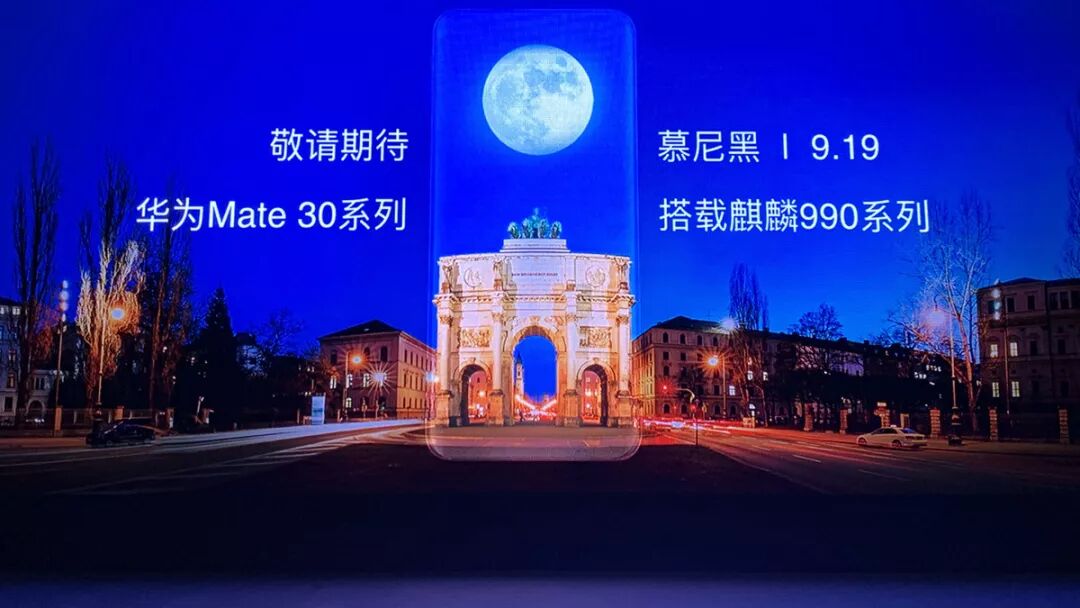 If the keyword for the release of Kirin 970 was AI capabilities, and for Kirin 980 it was the 7nm process, then the keyword for the release of Huawei’s Kirin 990 5G chip is the currently trending 5G technology. According to Yu Chengdong, the Exynos 980 released by Samsung next door is a chip that integrates a 5G modem, presented on a PowerPoint. In contrast, the Kirin 990 5G has a similar significance to last year’s Kirin 980, which debuted the 7nm process and A76 architecture: it is the world’s first flagship 5G SoC chip. There is little doubt that the Mate 30 series will become the first smartphone equipped with an integrated 5G modem SoC chip, ahead of Qualcomm’s Snapdragon 855+X50 modem or Huawei’s Kirin 980+Balong 5000 modem 5G smartphones. From this perspective, Huawei’s progress in 5G technology and products can be said to be ahead of its competitors.
If the keyword for the release of Kirin 970 was AI capabilities, and for Kirin 980 it was the 7nm process, then the keyword for the release of Huawei’s Kirin 990 5G chip is the currently trending 5G technology. According to Yu Chengdong, the Exynos 980 released by Samsung next door is a chip that integrates a 5G modem, presented on a PowerPoint. In contrast, the Kirin 990 5G has a similar significance to last year’s Kirin 980, which debuted the 7nm process and A76 architecture: it is the world’s first flagship 5G SoC chip. There is little doubt that the Mate 30 series will become the first smartphone equipped with an integrated 5G modem SoC chip, ahead of Qualcomm’s Snapdragon 855+X50 modem or Huawei’s Kirin 980+Balong 5000 modem 5G smartphones. From this perspective, Huawei’s progress in 5G technology and products can be said to be ahead of its competitors.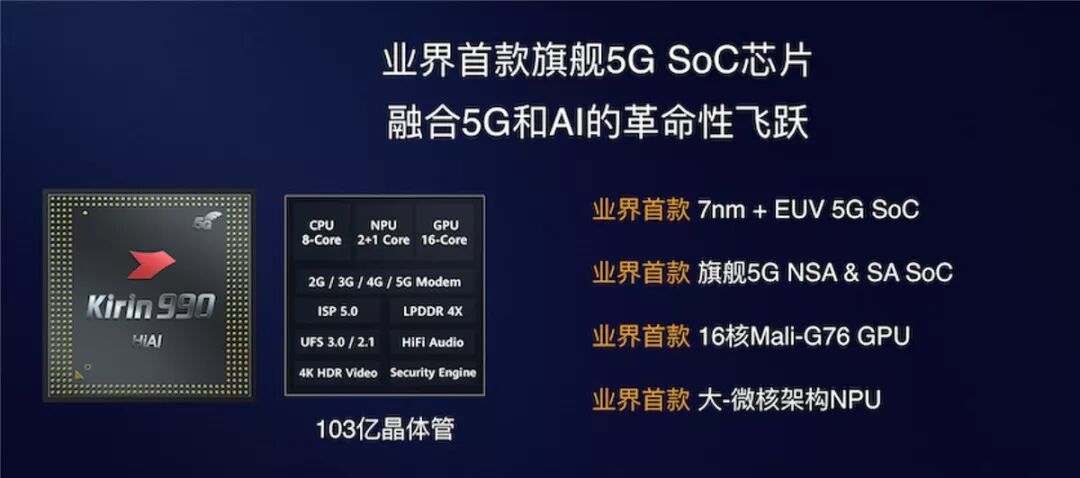

The Kirin 990 5G focuses on power consumption and weak signal connectivity. Although Yu Chengdong emphasized at the launch that the Kirin 990 5G chip integrates a 5G modem, achieving full network support for 2G, 3G, 4G, and 5G, and supports both 5G NSA and 5G SA networking modes, there was actually little discussion about the specific capabilities of the 5G modem in the Kirin 990 5G chip. The key points of the Kirin 990 5G chip’s 5G capabilities are as follows:
-
Achieves a peak download rate of 2.3Gbps and an uplink peak rate of 1.25Gbps in the Sub-6GHz frequency band.
-
Supports dual SIM 5G, allowing one SIM to access 5G while the other can receive VoLTE HD voice calls.
-
Compared to traditional 4G SoC + 5G modem solutions, it exhibits 20% better power consumption performance.
In fact, the theoretical peak rate of the Balong 5000 5G modem released by Huawei earlier this year can reach 4.6Gbps in the Sub-6GHz frequency band and 6.5Gbps in the mmWave frequency band. Therefore, Huawei may have opted not to push the 5G network capabilities of the Kirin 990 5G chip too high, possibly for power consumption or chip area considerations, and even did not include support for mmWave (which is indeed unnecessary). Thus, the main focus of the Kirin 990 5G chip has shifted to weak signal connectivity and power consumption. Huawei stated that in the early stages of 5G commercialization, due to incomplete network coverage, 5G still faces challenges such as unstable connections in weak signal scenarios, high power consumption, and poor connection experiences in high-speed moving scenarios, which affect users’ internet experience. To address this, the Kirin 990 5G chip introduces intelligent uplink splitting design in weak 5G signal scenarios, allowing simultaneous use of 5G and 4G networks for applications such as video live streaming and short video uploads, increasing upload speeds by 5.8 times. To solve the power consumption issues brought by 5G, the Kirin 990 5G chip is the first to support BWP (Bandwidth Part) technology, achieving flexible switching of bandwidth resources under 5G’s large bandwidth conditions, exhibiting 44% better 5G power consumption performance compared to mainstream flagship chips; for high-speed moving scenarios, the Kirin 990 5G supports a machine learning-based adaptive receiver, achieving more accurate channel measurements, increasing downlink rates by 19%, and ensuring stable 5G connections. Overall, when 5G modems were first integrated into SoC chips, manufacturers primarily considered basic user experience rather than theoretical data.
Huawei stated that in the early stages of 5G commercialization, due to incomplete network coverage, 5G still faces challenges such as unstable connections in weak signal scenarios, high power consumption, and poor connection experiences in high-speed moving scenarios, which affect users’ internet experience. To address this, the Kirin 990 5G chip introduces intelligent uplink splitting design in weak 5G signal scenarios, allowing simultaneous use of 5G and 4G networks for applications such as video live streaming and short video uploads, increasing upload speeds by 5.8 times. To solve the power consumption issues brought by 5G, the Kirin 990 5G chip is the first to support BWP (Bandwidth Part) technology, achieving flexible switching of bandwidth resources under 5G’s large bandwidth conditions, exhibiting 44% better 5G power consumption performance compared to mainstream flagship chips; for high-speed moving scenarios, the Kirin 990 5G supports a machine learning-based adaptive receiver, achieving more accurate channel measurements, increasing downlink rates by 19%, and ensuring stable 5G connections. Overall, when 5G modems were first integrated into SoC chips, manufacturers primarily considered basic user experience rather than theoretical data.
 Still using the A76 architecture, CPU performance slightly ahead of Snapdragon 855. Before the release of the Kirin 990 5G chip, a focal point in the industry was whether it would use the A77 architecture or continue with the A76 architecture for the big cores. Ultimately, Huawei opted to continue using the A76 architecture first introduced with the Kirin 980. However, in terms of process technology, the Kirin 990 5G chip has made progress, utilizing a 7nm+ EUV process, with a board area 36% smaller than other industry solutions, integrating a total of 10.3 billion transistors on the chip.
Still using the A76 architecture, CPU performance slightly ahead of Snapdragon 855. Before the release of the Kirin 990 5G chip, a focal point in the industry was whether it would use the A77 architecture or continue with the A76 architecture for the big cores. Ultimately, Huawei opted to continue using the A76 architecture first introduced with the Kirin 980. However, in terms of process technology, the Kirin 990 5G chip has made progress, utilizing a 7nm+ EUV process, with a board area 36% smaller than other industry solutions, integrating a total of 10.3 billion transistors on the chip.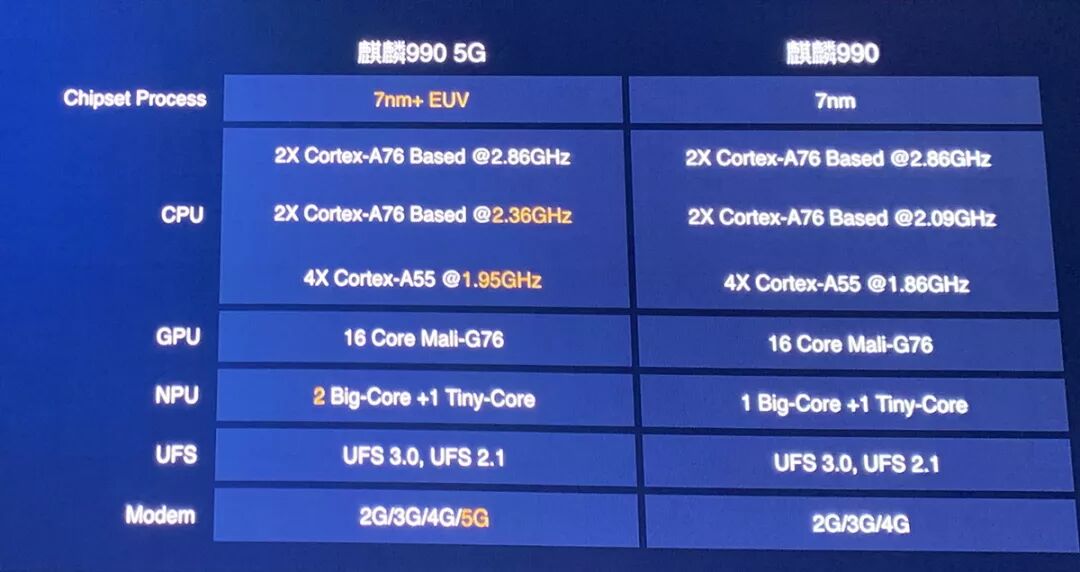 ▲ The Kirin 990 series is divided into Kirin 990 and Kirin 990 5G. The launch event focused on the specific architecture of the Kirin 990 5G, which adopts a three-tier energy efficiency architecture with 2 big cores (developed based on Cortex-A76) + 2 middle cores (developed based on Cortex-A76) + 4 small cores (Cortex-A55). When the Kirin 980 was released last year, the main frequency of the big cores was controlled at 2.6GHz, and the middle cores were even below 2.0GHz. Now, after updating to a new generation, the main frequencies of all three types of cores have been increased, with the Kirin 990 5G chip’s big cores reaching a maximum frequency of 2.86GHz, middle cores at 2.35GHz, and energy-efficient small cores at 1.95GHz.
▲ The Kirin 990 series is divided into Kirin 990 and Kirin 990 5G. The launch event focused on the specific architecture of the Kirin 990 5G, which adopts a three-tier energy efficiency architecture with 2 big cores (developed based on Cortex-A76) + 2 middle cores (developed based on Cortex-A76) + 4 small cores (Cortex-A55). When the Kirin 980 was released last year, the main frequency of the big cores was controlled at 2.6GHz, and the middle cores were even below 2.0GHz. Now, after updating to a new generation, the main frequencies of all three types of cores have been increased, with the Kirin 990 5G chip’s big cores reaching a maximum frequency of 2.86GHz, middle cores at 2.35GHz, and energy-efficient small cores at 1.95GHz.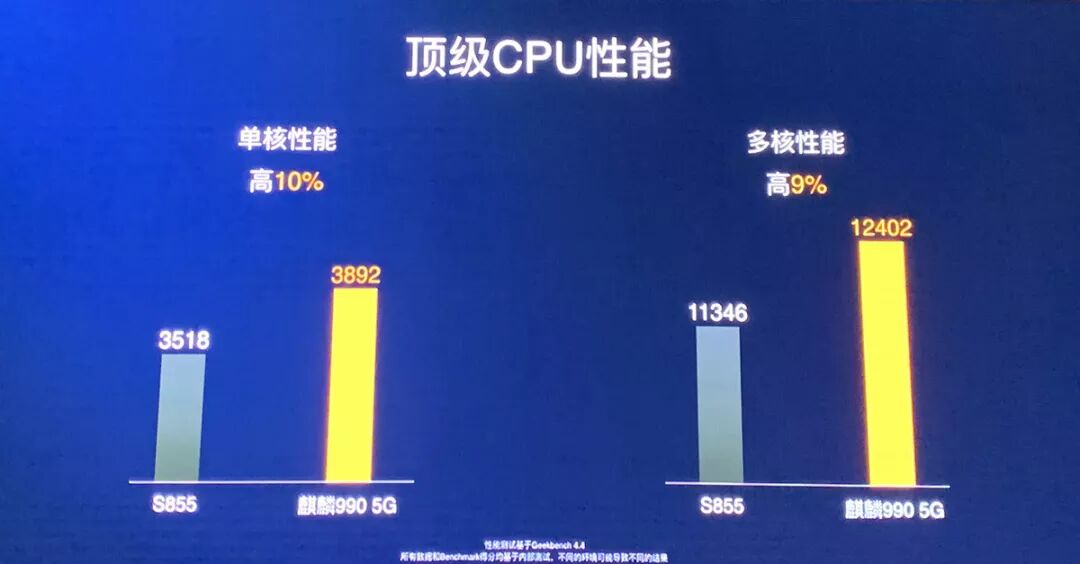 In comparison with the Snapdragon 855, the Kirin 990 5G chip has a slight edge. Specifically, in the GeekBench 4.4 benchmark, the single-core performance of the Kirin 990 5G is 10% higher than that of the Snapdragon 855, and the multi-core performance is 9% higher, with scores of 3892 for single-core and 12402 for multi-core.
In comparison with the Snapdragon 855, the Kirin 990 5G chip has a slight edge. Specifically, in the GeekBench 4.4 benchmark, the single-core performance of the Kirin 990 5G is 10% higher than that of the Snapdragon 855, and the multi-core performance is 9% higher, with scores of 3892 for single-core and 12402 for multi-core. In terms of GPU, the Kirin 990 5G chip is equipped with a 16-core Mali-G76 GPU. Huawei states that compared to the 10-core Mali-G76 GPU in the Kirin 980, it has 6 more cores, which can save up to 15% bandwidth in high-load gaming and other high-bandwidth scenarios, and reduce power consumption by 12%.
In terms of GPU, the Kirin 990 5G chip is equipped with a 16-core Mali-G76 GPU. Huawei states that compared to the 10-core Mali-G76 GPU in the Kirin 980, it has 6 more cores, which can save up to 15% bandwidth in high-load gaming and other high-bandwidth scenarios, and reduce power consumption by 12%. Advantageous areas: ISP and AI capabilities further enhanced. Since the Kirin 970, Huawei has focused on AI performance, first adopting a dedicated NPU (Neural Processing Unit). The Kirin 810 chip then utilized Huawei’s self-developed Da Vinci architecture NPU.
Advantageous areas: ISP and AI capabilities further enhanced. Since the Kirin 970, Huawei has focused on AI performance, first adopting a dedicated NPU (Neural Processing Unit). The Kirin 810 chip then utilized Huawei’s self-developed Da Vinci architecture NPU.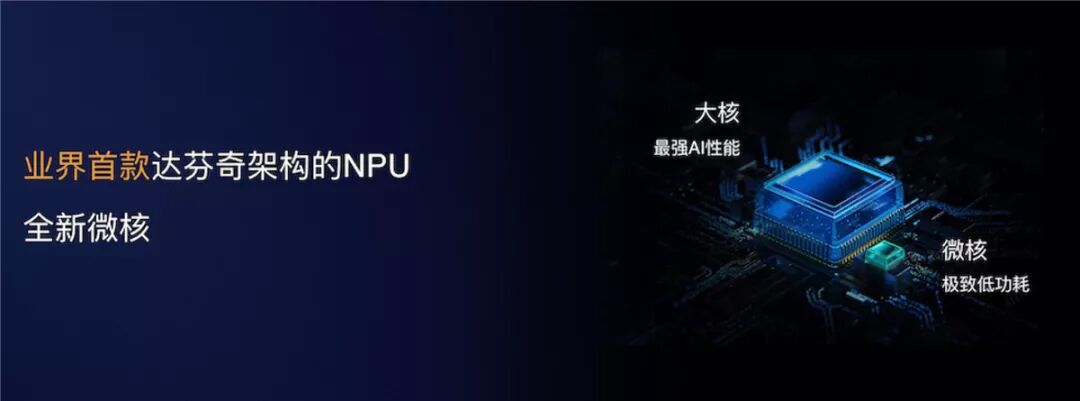 This time, the Kirin 990 5G chip is the first flagship chip to adopt Huawei’s self-developed Da Vinci architecture NPU, featuring a dual big core + micro core computing architecture for the NPU, where the big core showcases performance and efficiency, while the micro core NPU achieves ultra-low power consumption. For instance, this industry-first micro core NPU (Ascend Tiny) can improve energy efficiency by up to 24 times in facial recognition applications, making AI computations more power-efficient.
This time, the Kirin 990 5G chip is the first flagship chip to adopt Huawei’s self-developed Da Vinci architecture NPU, featuring a dual big core + micro core computing architecture for the NPU, where the big core showcases performance and efficiency, while the micro core NPU achieves ultra-low power consumption. For instance, this industry-first micro core NPU (Ascend Tiny) can improve energy efficiency by up to 24 times in facial recognition applications, making AI computations more power-efficient. Yu Chengdong stated that compared to Qualcomm and Samsung’s SoCs, the Kirin 990 5G chip has a performance advantage of up to 6 times and an energy efficiency advantage of up to 8 times. At the event, Huawei also demonstrated a case showcasing the AI computing power of the Kirin 990 5G chip: through AI multi-instance segmentation technology, it can individually recognize each subject in a video frame, allowing for multi-person video shooting with background replacement, and even selecting which subjects to retain in the frame. Additionally, AI video super-resolution can restore the video quality captured by older devices to achieve HD quality. Huawei’s flagship smartphones have long occupied the top position in the DxO camera capability rankings, and photography has become one of the hallmarks of Huawei phones, which is related to the larger CMOS used in Huawei’s flagship devices, the research and tuning of the imaging team, and of course, the ISP (Image Signal Processor) of the Kirin chips.
Yu Chengdong stated that compared to Qualcomm and Samsung’s SoCs, the Kirin 990 5G chip has a performance advantage of up to 6 times and an energy efficiency advantage of up to 8 times. At the event, Huawei also demonstrated a case showcasing the AI computing power of the Kirin 990 5G chip: through AI multi-instance segmentation technology, it can individually recognize each subject in a video frame, allowing for multi-person video shooting with background replacement, and even selecting which subjects to retain in the frame. Additionally, AI video super-resolution can restore the video quality captured by older devices to achieve HD quality. Huawei’s flagship smartphones have long occupied the top position in the DxO camera capability rankings, and photography has become one of the hallmarks of Huawei phones, which is related to the larger CMOS used in Huawei’s flagship devices, the research and tuning of the imaging team, and of course, the ISP (Image Signal Processor) of the Kirin chips. This time, the Kirin 990 5G adopts a new ISP 5.0, with a throughput rate increase of 15%, energy efficiency improvement of 15%, and comprehensive optimization of video processing capabilities, especially in video noise reduction.
This time, the Kirin 990 5G adopts a new ISP 5.0, with a throughput rate increase of 15%, energy efficiency improvement of 15%, and comprehensive optimization of video processing capabilities, especially in video noise reduction. The ability of smartphones to take photos in low-light conditions has always been a focus for users. Huawei stated that this time they are not claiming to surpass DSLRs, but have new technology that can “match DSLRs”: the Kirin 990 5G chip is the first to implement BM3D (Block-Matching and 3D filtering) DSLR-level hardware noise reduction technology in a mobile chip, improving photo noise reduction capabilities by 30% and reducing noise in low-light scenes.
The ability of smartphones to take photos in low-light conditions has always been a focus for users. Huawei stated that this time they are not claiming to surpass DSLRs, but have new technology that can “match DSLRs”: the Kirin 990 5G chip is the first to implement BM3D (Block-Matching and 3D filtering) DSLR-level hardware noise reduction technology in a mobile chip, improving photo noise reduction capabilities by 30% and reducing noise in low-light scenes.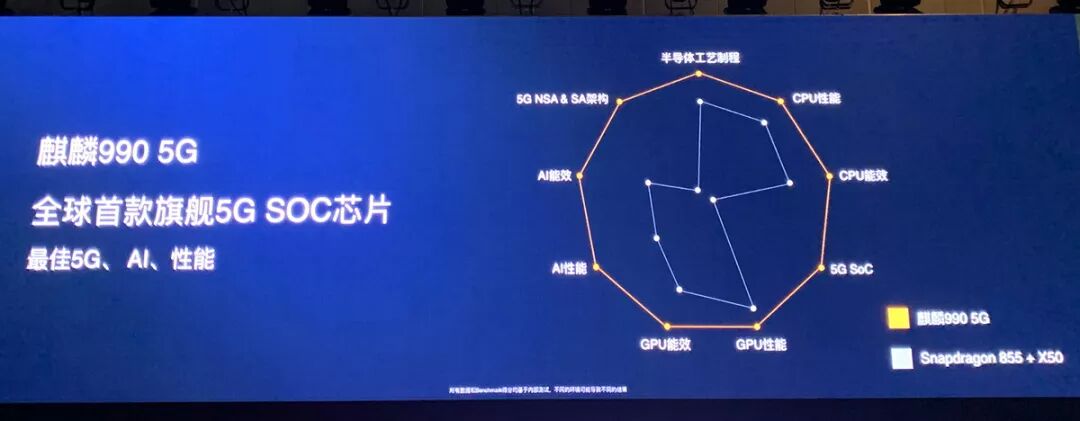 As is customary, the end of the Kirin flagship chip launch event always features a nine-square comparison chart to ‘beat’ Qualcomm, and this time is no exception. However, compared to last year’s slight friction, this time Qualcomm’s chip performance in Huawei’s PPT can only be described as ‘battle five scum’. We look forward to how Snapdragon 865 will make a comeback next year.
As is customary, the end of the Kirin flagship chip launch event always features a nine-square comparison chart to ‘beat’ Qualcomm, and this time is no exception. However, compared to last year’s slight friction, this time Qualcomm’s chip performance in Huawei’s PPT can only be described as ‘battle five scum’. We look forward to how Snapdragon 865 will make a comeback next year.